Exploring Impact of Age and Gender on Sentiment Analysis Using Machine Learning
Abstract
1. Introduction
- Exploring the impact of user expression based on age and gender using different feature extraction methods.
- We create a dataset that contains user reviews along with the user’s age and gender information.
- A detailed analysis on the impact of user expression is presented through extensive experiments.
- Finally, a comparison with different machine learning and a dictionary-based classifier is also discussed.
2. Related Work
3. Methodology
3.1. Feature Extraction
3.1.1. Bag-of-Words
3.1.2. Word2Vec
3.2. Dictionary-Based Classifier
3.3. Machine Learning Based Classifiers
3.3.1. Naive Bayes
3.3.2. Maximum Entropy
3.3.3. Support Vector Machine (SVM)
3.3.4. Long Short Term Memory (LSTM)
3.3.5. Convolution Neural Network (CNN)
4. Experiments and Discussion
4.1. Dataset Description
4.2. Result Analysis
4.2.1. Effect of Age
4.2.2. Effect of Gender
5. Conclusions and Future Work
Author Contributions
Funding
Acknowledgments
Conflicts of Interest
References
- Manek, A.S.; Shenoy, P.D.; Mohan, M.C.; Venugopal, K. Aspect term extraction for sentiment analysis in large movie reviews using gini index feature selection method and svm classifier. Worldw. Web 2017, 20, 135–154. [Google Scholar] [CrossRef]
- Dos Santos, C.; Gatti, M. Deep convolutional neural networks for sentiment analysis of short texts. In Proceedings of the COLING, the 25th International Conference on Computational Linguistics: Technical Papers, Dublin, Ireland, 23–29 August 2014; pp. 69–78. [Google Scholar]
- Kiritchenko, S.; Zhu, X.; Cherry, C.; Mohammad, S. Nrc-canada-2014: Detecting aspects and sentiment in customer reviews. In Proceedings of the 8th International Workshop on Semantic Evaluation, Dublin, Ireland, 23–24 August 2014; pp. 437–442. [Google Scholar]
- Pontiki, M.; Galanis, D.; Papageorgiou, H.; Manandhar, S.; Androutsopoulos, I. Semeval-2015 task 12: Aspect based sentiment analysis. In Proceedings of the 9th International Workshop on Semantic Evaluation, Denver, CO, USA, 4–5 June 2015; pp. 486–495. [Google Scholar]
- Cao, D.; Ji, R.; Lin, D.; Li, S. A cross-media public sentiment analysis system for microblog. Multim. Syst. 2016, 22, 479–486. [Google Scholar] [CrossRef]
- Ghosh, R.; Zhang, L.; Dekhil, M.E.; Liu, B. Performing sentiment analysis on microblogging data, including identifying a new opinion term therein. US Patent 9,275,041, 1 March 2016. [Google Scholar]
- Ullah, M.A.; Islam, M.M.; Azman, N.B.; Zaki, Z.M. An overview of multimodal sentiment analysis research: Opportunities and difficulties. In Proceedings of the 2017 IEEE International Conference on Imaging, Vision & Pattern Recognition, Himeji, Japan, 1–3 September 2017; pp. 1–6. [Google Scholar]
- Cambria, E. Affective computing and sentiment analysis. IEEE Intell. Syst. 2016, 31, 102–107. [Google Scholar] [CrossRef]
- Liu, B. Sentiment analysis and subjectivity. Handb. Nat. Lang. Proc. 2010, 2, 627–666. [Google Scholar]
- Kumar, S.; Yadava, M.; Roy, P.P. Fusion of eeg response and sentiment analysis of products review to predict customer satisfaction. Inf. Fus. 2019, 52, 41–52. [Google Scholar] [CrossRef]
- Kim, J.H.; Kim, B.G.; Roy, P.P.; Jeong, D.M. Efficient facial expression recognition algorithm based on hierarchical deep neural network structure. IEEE Access 2019, 7, 41273–41285. [Google Scholar] [CrossRef]
- Yoo, S.M.; Cho, C.; Lee, K.H.; Park, J.; Jin, S.; Lee, Y.; Kim, B.G. Structure of deep learning inference engines for embedded systems. In Proceedings of the IEEE 2019 International Conference on Information and Communication Technology Convergence, Kuala Lumpur, Malaysia, 24–26 July 2019; pp. 920–922. [Google Scholar]
- Kim, J.H.; Hong, G.S.; Kim, B.G.; Dogra, D.P. Deepgesture: Deep learning-based gesture recognition scheme using motion sensors. Displays 2018, 55, 38–45. [Google Scholar] [CrossRef]
- Kahaki, S.M.M.; Ismail, W.; Nordin, M.J.; Ahmad, N.S.; Ahmad, M. Automated age estimation based on geometric mean projection transform using orthopantomographs. J. Adv. Technol. Eng. Stud. 2017, 3, 6–10. [Google Scholar]
- Kahaki, S.M.; Nordin, M.J.; Ahmad, N.S.; Arzoky, M.; Ismail, W. Deep convolutional neural network designed for age assessment based on orthopantomography data. Neural Comput. Appl. 2019, 3, 1–12. [Google Scholar] [CrossRef]
- Li, Y.M.; Li, T.Y. Deriving market intelligence from microblogs. Decis. Support Syst. 2013, 55, 206–217. [Google Scholar] [CrossRef]
- Lockenhoff, C.E.; Costa, P.T.; Lane, R.D. Age differences in descriptions of emotional experiences in oneself and others. J. Gerontol. Ser. B Psychol. Sci. Soc. Sci. 2008, 63, 92–99. [Google Scholar] [CrossRef] [PubMed]
- Zimmermann, P.; Iwanski, A. Emotion regulation from early adolescence to emerging adulthood and middle adulthood. Int. J. Behav. Dev. 2014, 38, 182–194. [Google Scholar] [CrossRef]
- Kaur, B.; Singh, D.; Roy, P.P. Age and gender classification using brain–computer interface. Neural Comput. Appl. 2019, 31, 5887–5900. [Google Scholar] [CrossRef]
- Oh, H.; Parks, S.C.; Demicco, F.J. Age-and gender-based market segmentation: A structural understanding. Int. J. Hosp. Tour. Adm. 2002, 3, 1–20. [Google Scholar] [CrossRef]
- Keshari, P.; Jain, S. Effect of age and gender on consumer response to advertising appeals. Paradigm 2016, 20, 69–82. [Google Scholar] [CrossRef]
- Appel, O.; Chiclana, F.; Carter, J.; Fujita, H. Successes and challenges in developing a hybrid approach to sentiment analysis. Appl. Intell. 2018, 48, 1176–1188. [Google Scholar] [CrossRef]
- Zainuddin, N.; Selamat, A.; Ibrahim, R. Hybrid sentiment classification on twitter aspect-based sentiment analysis. Appl. Intell. 2018, 48, 1218–1232. [Google Scholar] [CrossRef]
- Fan, T.K.; Chang, C.H. Sentiment-oriented contextual advertising. Knowl. Inf. Syst. 2010, 23, 321–344. [Google Scholar] [CrossRef]
- Kuo, Y.H.; Fu, M.H.; Tsai, W.H.; Lee, K.R.; Chen, L.Y. Integrated microblog sentiment analysis from users’ social interaction patterns and textual opinions. Appl. Intell. 2016, 44, 399–413. [Google Scholar] [CrossRef]
- Li, G.; Liu, F. Sentiment analysis based on clustering: a framework in improving accuracy and recognizing neutral opinions. Appl. Intell. 2014, 40, 441–452. [Google Scholar] [CrossRef]
- Ali, F.; Kim, E.K.; Kim, Y.G. Type-2 fuzzy ontology-based opinion mining and information extraction: A proposal to automate the hotel reservation system. Appl. Intell. 2015, 42, 481–500. [Google Scholar] [CrossRef]
- Pak, A.; Paroubek, P. Twitter as a corpus for sentiment analysis and opinion mining. In LREC; University of Paris: Paris, France, 2010; pp. 1320–1326. [Google Scholar]
- Denecke, K. Using sentiwordnet for multilingual sentiment analysis. In Proceedings of the IEEE 24th International Conference on Data Engineering Workshop, Cancun, Mexico, 7–12 April 2008; pp. 507–512. [Google Scholar]
- Zhou, G.; Zhu, Z.; He, T.; Hu, X.T. Cross-lingual sentiment classification with stacked autoencoders. Knowl. Inf. Syst. 2016, 47, 27–44. [Google Scholar] [CrossRef]
- Cheng, J.; Zhang, X.; Li, P.; Zhang, S.; Ding, Z.; Wang, H. Exploring sentiment parsing of microblogging texts for opinion polling on chinese public figures. Appl. Intell. 2016, 45, 429–442. [Google Scholar] [CrossRef]
- Fabes, R.A.; Martin, C.L. Gender and age stereotypes of emotionality. Personal. Soc. Psychol. Bull. 1991, 17, 532–540. [Google Scholar] [CrossRef]
- Stoner, S.B.; Spencer, W.B. Age and gender differences with the anger expression scale. Educ. Psychol. Meas. 1987, 47, 487–492. [Google Scholar] [CrossRef]
- Davis, T.L. Gender differences in masking negative emotions: Ability or motivation? Dev. Psychol. 1995, 31, 660–667. [Google Scholar] [CrossRef]
- Brody, L.R. Gender and emotion: Beyond stereotypes. J. Soc. Issues 2010, 53, 369–393. [Google Scholar] [CrossRef]
- Kring, A.M.; Gordon, A.H. Sex differences in emotion: Expression, experience, and physiology. J. Personal. Soc. Psychol. 1998, 74, 686–703. [Google Scholar] [CrossRef]
- Birditt, K.S.; Fingerman, K.L. Age and gender differences in adults’ descriptions of emotional reactions to interpersonal problems. J. Gerontol. Ser. B Psychol. Sci. Soc. Sci. 2003, 58, 237–245. [Google Scholar] [CrossRef]
- Kharde, V.A.; Sonawane, S.S. Sentiment analysis of Twitter data: A survey of techniques. Int. J. Comput. Appl. 2016, 139, 5–15. [Google Scholar]
- Saini, R.; Kumar, P.; Roy, P.P.; Pal, U. Trajectory classification using feature selection by genetic algorithm. In Proceedings of the 3rd International Conference on Computer Vision and Image Processing; Springer: Berlin/Heidelberg, Germany, 2020; pp. 377–388. [Google Scholar]
- Xue, B.; Fu, C.; Shaobin, Z. A study on sentiment computing and classification of Sina Weibo with Word2vec. In Proceedings of the IEEE International Congress on Big Data, Anchorage, AK, USA, 27 June–2 July 2014; pp. 358–363. [Google Scholar]
- Hutto, C.J.; Gilbert, E. Vader: A parsimonious rule-based model for sentiment analysis of social media text. In Proceedings of the 8th International Conference on Weblogs and Social Media, Ann Arbor, MI, USA, 1–4 June 2014; pp. 216–255. [Google Scholar]
- Zhang, H. The optimality of naive bayes. AA 2004, 1, 1–6. [Google Scholar]
- Nigam, K.; Lafferty, J.; McCallum, A. Using maximum entropy for text classification. In IJCAI-99 Workshop on Machine Learning for Information Filtering; IJCAI: Stockholom, Sweden, 1999; Volume 1, pp. 61–67. [Google Scholar]
- Kaufmann, J.M. JMaxAlign: A maximum entropy parallel sentence alignment tool. In Proceedings of the COLING 2012: Demonstration Papers, Mumbai, India, 8–15 December 2012; pp. 277–288. [Google Scholar]
- Mullen, T.; Collier, N. Sentiment analysis using support vector machines with diverse information sources. In Proceedings of the 2004 Conference on Empirical Methods in Natural Language Processing, Barcelona, Spain, 25–26 July 2004; pp. 412–418. [Google Scholar]
- Saini, R.; Kumar, P.; Kaur, B.; Roy, P.P.; Dogra, D.P.; Santosh, K. Kinect sensor-based interaction monitoring system using the blstm neural network in healthcare. Int. J. Mach. Learn. Cybern. 2019, 10, 2529–2540. [Google Scholar] [CrossRef]
- Hochreiter, S.; Schmidhuber, J. Long short-term memory. Neural Comput. 1997, 9, 1735–1780. [Google Scholar] [CrossRef] [PubMed]
- LeCun, Y.; Bottou, L.; Bengio, Y.; Haffner, P. Gradient-based learning applied to document recognition. Proc. IEEE 1998, 86, 2278–2324. [Google Scholar] [CrossRef]
- Kim, Y. Convolutional neural networks for sentence classification. In Proceedings of the 2014 Conference on Empirical Methods in Natural Language Processing (EMNLP), Doha, Qatar, 25–29 October 2014; pp. 1746–1751. [Google Scholar]
- Saito, T.; Rehmsmeier, M. The precision-recall plot is more informative than the roc plot when evaluating binary classifiers on imbalanced datasets. PLoS ONE 2015, 10, e0118432. [Google Scholar] [CrossRef] [PubMed]
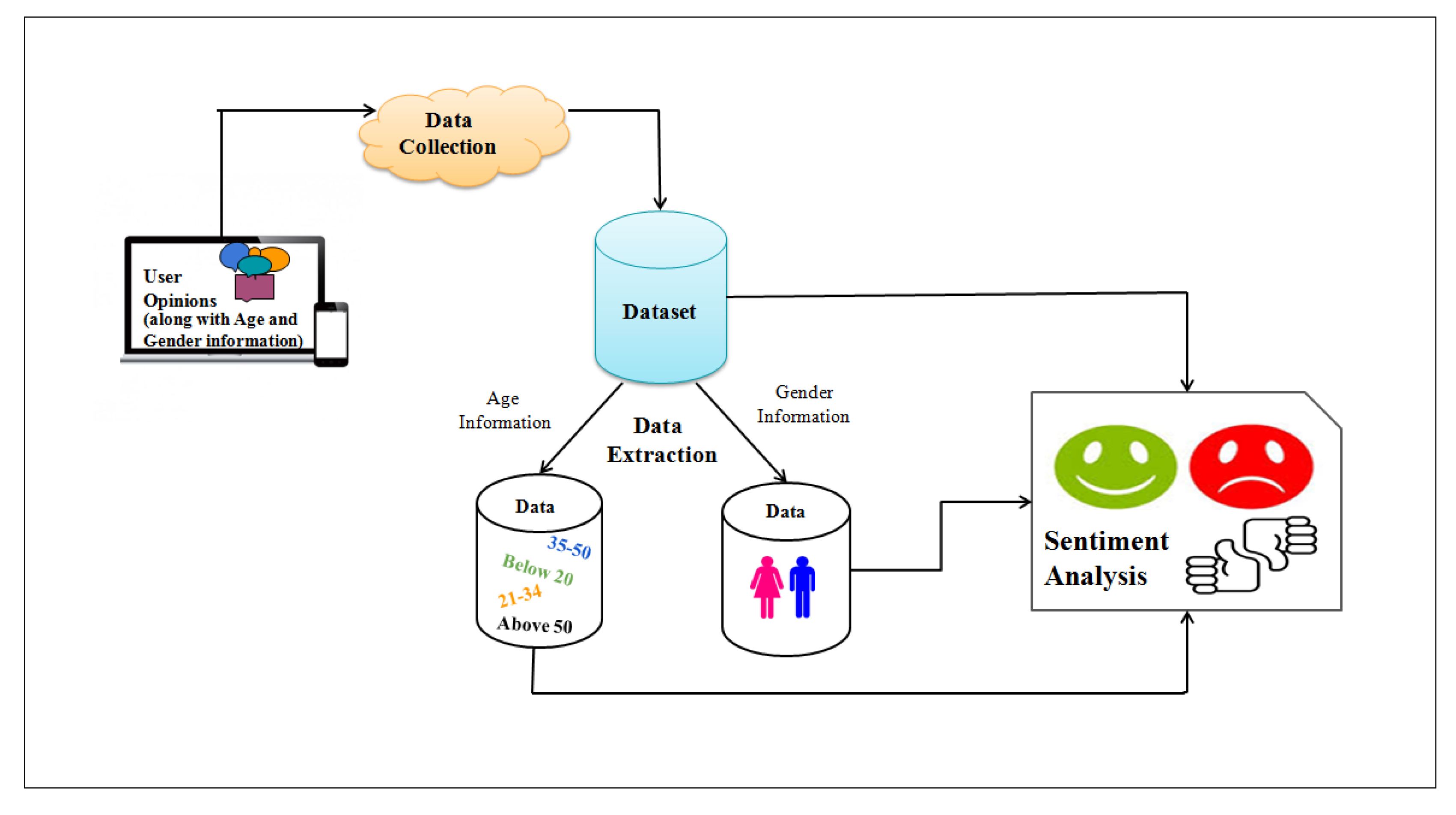
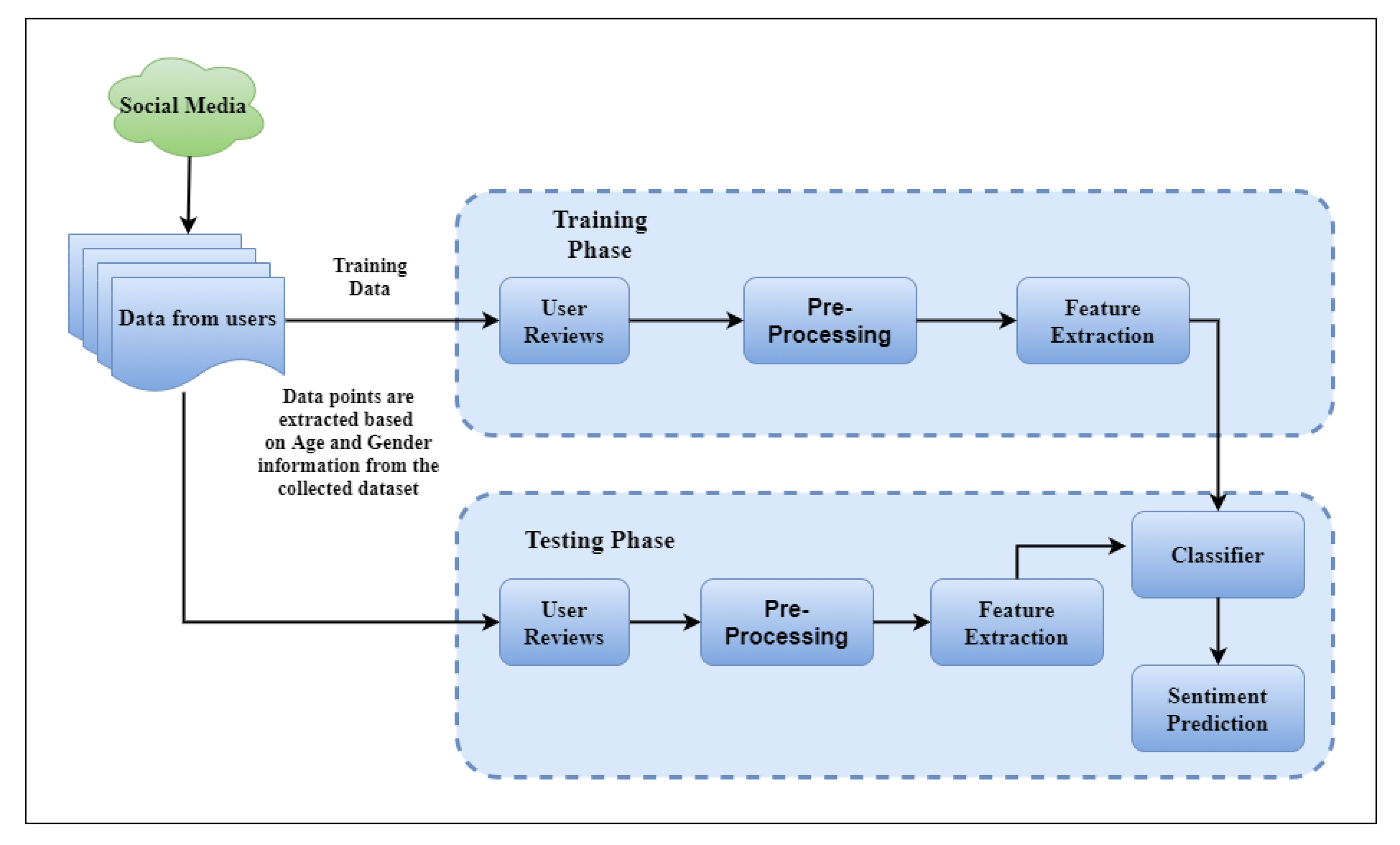
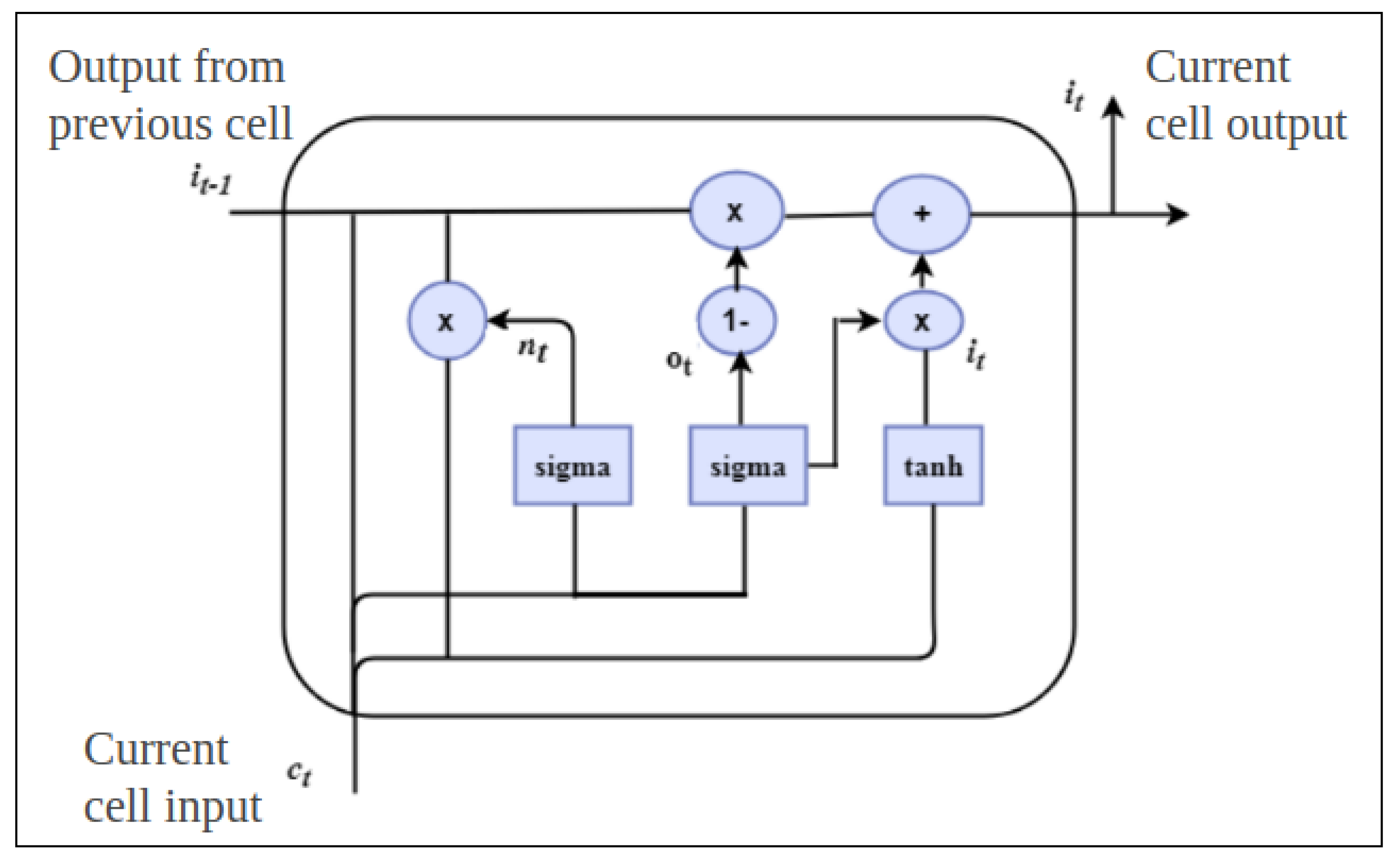
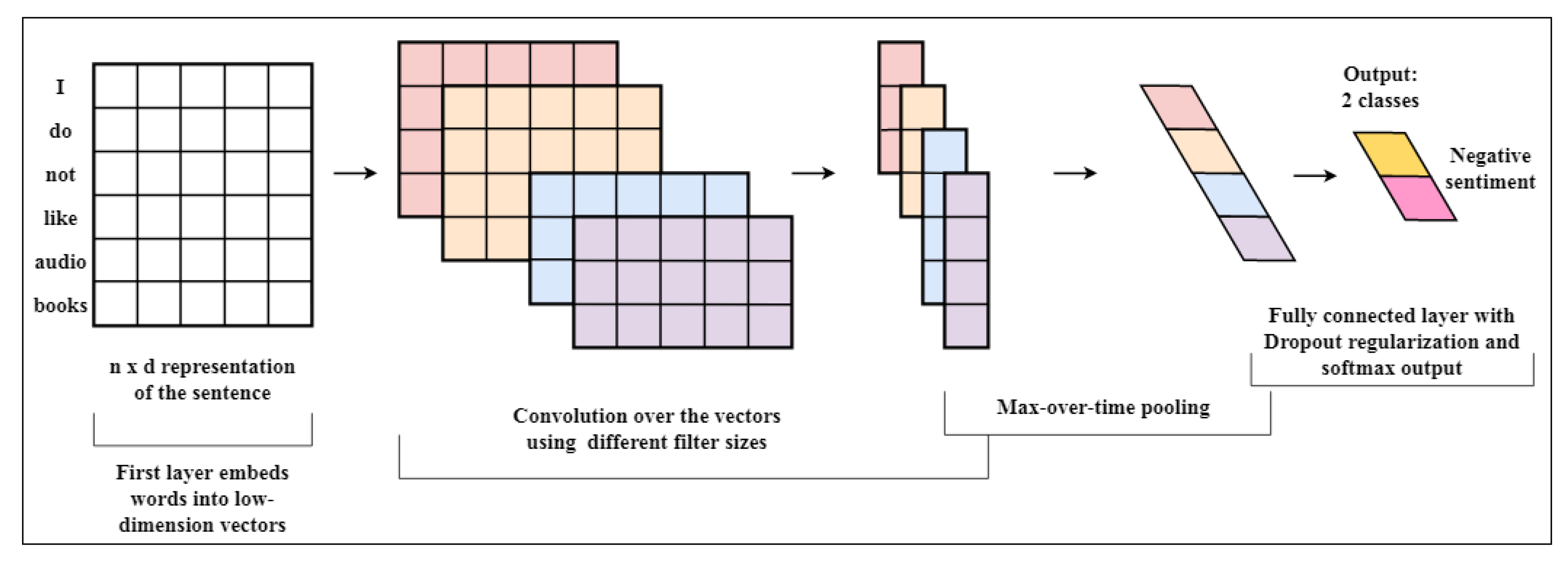

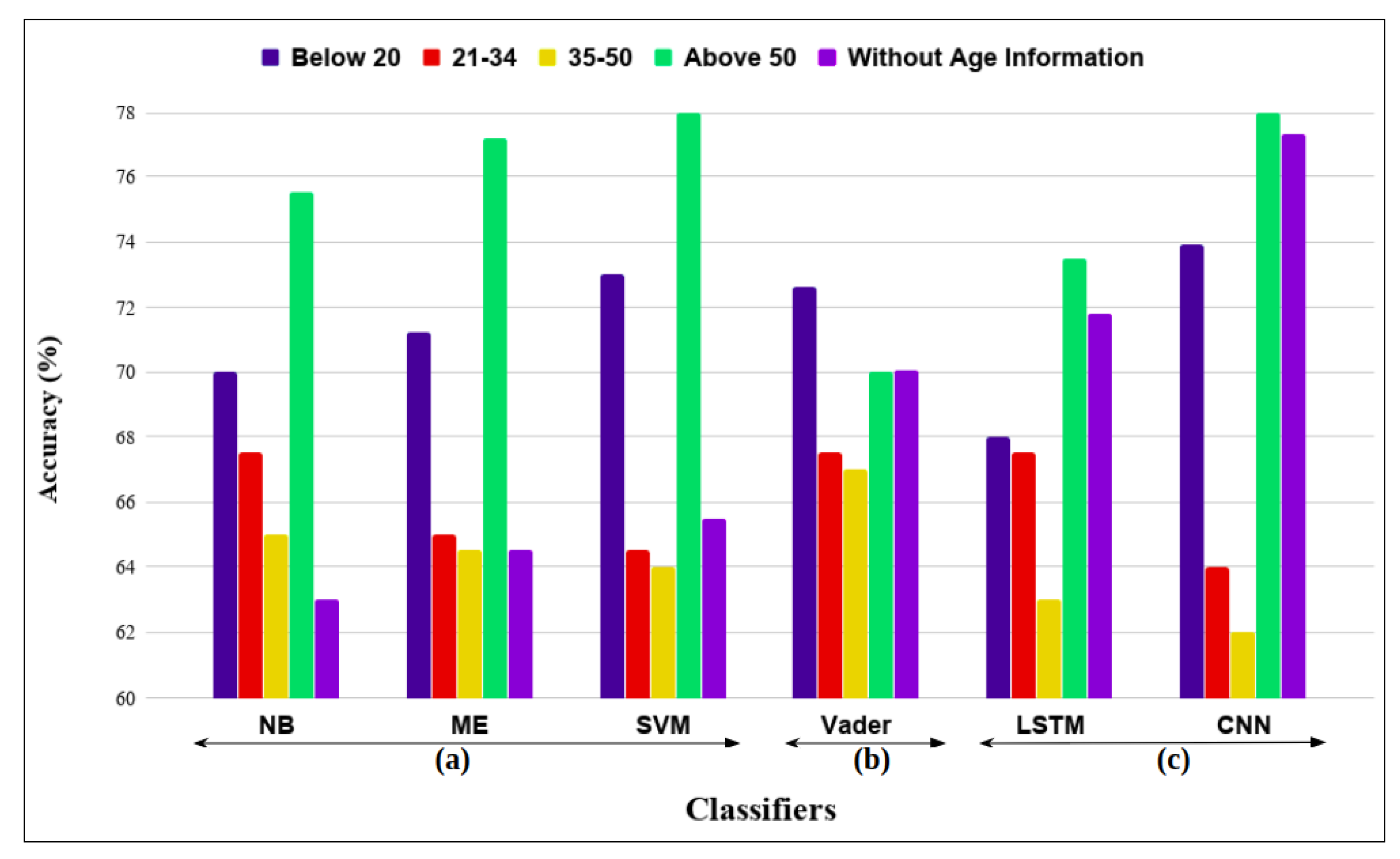
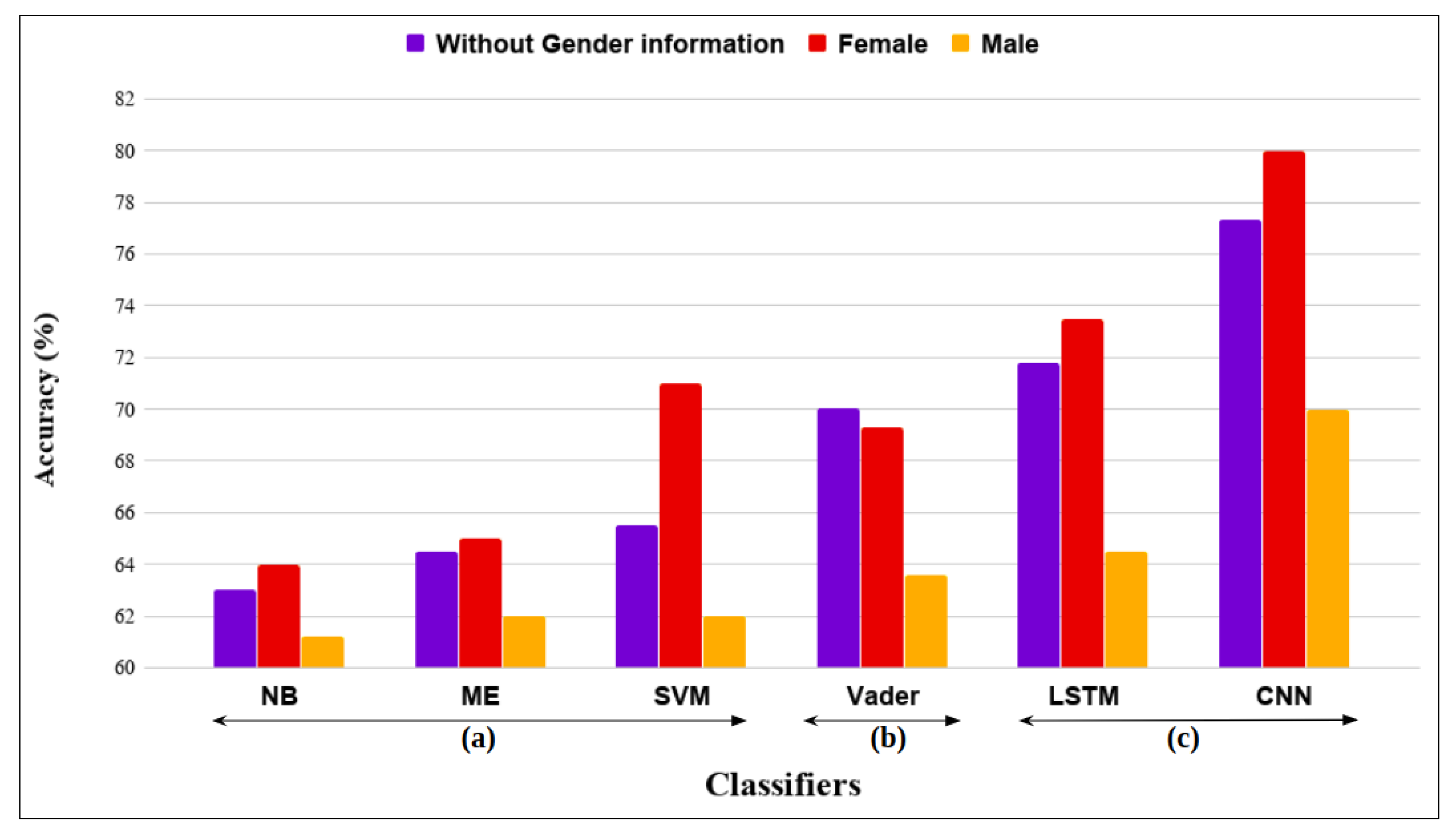
| S.No. | Description of Noisy and Uninformative Parts in Reviews |
|---|---|
| 1. | Removing punctuations, numbers and symbols since they do not add any substantial meaning to the sentence that may affect it’s sentiment score. |
| 2. | Removing stop words as they make no impact on the sentiment score of the expressed opinion. |
| 3. | Replacing the acronyms of a word with the actual word. |
| 4. | Transforming the text to lowercase. |
| 5. | Replacing emoticons with the sentiment that the emoticon expresses. |
| 6. | Tokenize the review. |
© 2020 by the authors. Licensee MDPI, Basel, Switzerland. This article is an open access article distributed under the terms and conditions of the Creative Commons Attribution (CC BY) license (http://creativecommons.org/licenses/by/4.0/).
Share and Cite
Kumar, S.; Gahalawat, M.; Roy, P.P.; Dogra, D.P.; Kim, B.-G. Exploring Impact of Age and Gender on Sentiment Analysis Using Machine Learning. Electronics 2020, 9, 374. https://doi.org/10.3390/electronics9020374
Kumar S, Gahalawat M, Roy PP, Dogra DP, Kim B-G. Exploring Impact of Age and Gender on Sentiment Analysis Using Machine Learning. Electronics. 2020; 9(2):374. https://doi.org/10.3390/electronics9020374
Chicago/Turabian StyleKumar, Sudhanshu, Monika Gahalawat, Partha Pratim Roy, Debi Prosad Dogra, and Byung-Gyu Kim. 2020. "Exploring Impact of Age and Gender on Sentiment Analysis Using Machine Learning" Electronics 9, no. 2: 374. https://doi.org/10.3390/electronics9020374
APA StyleKumar, S., Gahalawat, M., Roy, P. P., Dogra, D. P., & Kim, B.-G. (2020). Exploring Impact of Age and Gender on Sentiment Analysis Using Machine Learning. Electronics, 9(2), 374. https://doi.org/10.3390/electronics9020374





